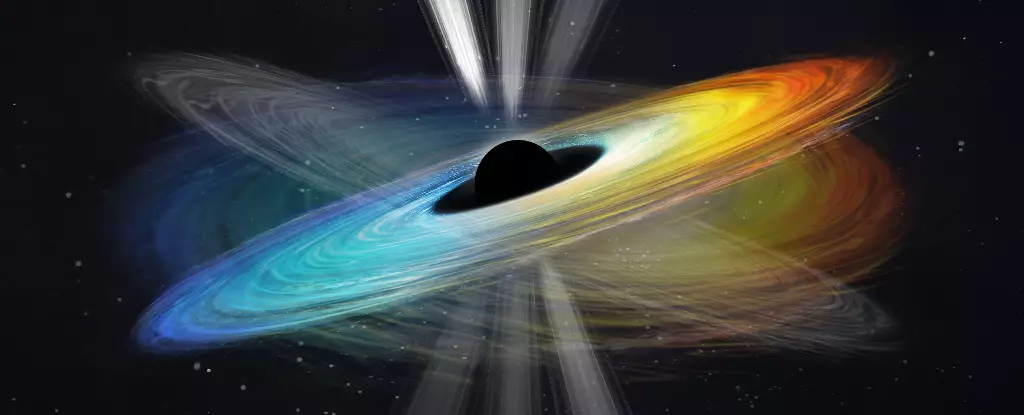The allure of black holes has captivated scientists and curious minds for generations. Their mysterious nature and immense gravitational pull have sparked countless scientific pursuits to understand these enigmatic cosmic entities. In 2019, the scientific community made a groundbreaking achievement by capturing the first-ever image of a black hole, specifically the supermassive monster residing at the core of the Messier 87 galaxy. However, this captivating discovery was merely the beginning of unraveling the secrets concealed within the enigmatic realm of black holes.
One of the central mysteries surrounding black holes is whether they possess the ability to spin. In a recent study, astrophysicists shed light on this inquiry by meticulously analyzing 22 years’ worth of observations of the M87 galaxy’s core. By utilizing a network of over 20 telescopes scattered around the globe, researchers scrutinized 170 observations taken between 2000 and 2022. While peering into the heart of the black hole remains impossible due to its unfathomable gravitational forces, scientists managed to observe the mesmerizing jet emitted by the black hole.
The black hole’s jet, a magnificent phenomenon spanning 4,900 light years and deceivingly appearing to move five times faster than the speed of light due to a compelling optical illusion called superluminal motion, had been a subject of interest for scientists since its first sighting by astronomer Heber Curtis in 1918. The Hubble Space Telescope further immortalized this awe-inspiring spectacle. Although the precise mechanisms leading to the formation of these powerful jets remain unclear, scientists hypothesize that radiation and particles are channeled along the black hole’s magnetic field lines.
What truly astonished researchers during their analysis was the black hole’s ability to alter the angle of its jet by approximately 10 degrees before returning to its original position. This remarkable transformation takes approximately 11 years to complete, providing compelling evidence of the black hole’s spinning nature. Rotating black holes induce a phenomenon known as frame-dragging, whereby they twist the fabric of space and time surrounding them. This effect causes the accretion disk and the jet to deviate from their initial orientation.
The significance of this discovery lies not only in confirming the spinning nature of the black hole but also in the arduous process involved in reaching this conclusion. The small misalignment between the black hole and its accretion disk, paired with the 11-year precession period, made the accumulation of high-resolution data spanning two decades and meticulous analysis truly imperative. The intricate nature of black holes demands unwavering perseverance and dedication from the scientific community to unlock their enduring mysteries.
Among the countless galaxies dotting the cosmic landscape, M87 holds particular intrigue for scientists due to its relatively close proximity of only 54 million light-years away compared to other galaxies. Astronomer Charles Messier first laid eyes on this galactic wonder in 1781 when he directed his telescope toward the constellation Virgo. His discovery garnered the galaxy the name Messier 87, or simply M87. This accessible distance makes M87 a prime candidate for in-depth observation and analysis, presenting scientists with a unique opportunity to expand their understanding of black holes.
The extraordinary revelation regarding the spinning nature of black holes raises further questions about the astonishing speeds at which they rotate. Most black holes are believed to spin at nearly the speed of light, as demonstrated by previous observations. In 2013, a black hole located in the NGC 1365 galaxy, situated approximately 60 million light-years away, exhibited a rotation speed of 84 percent of the speed of light. Subsequently, in 2019, scientists inferred the spinning nature of another black hole by studying X-ray pulse patterns, revealing a rotation speed of 50 percent of the speed of light.
The swiftness at which black holes rotate can be attributed to the laws of conservation of angular momentum. As matter collapses into a singularity or a black hole, it undergoes a mind-boggling compression, significantly reducing its volume while retaining its angular momentum. Comparable to an ice-skater pulling their arms inward, thereby increasing their rotational speed, the matter derived from a spinning star experiences an analogous phenomenon during its collapse into a black hole.
The exploration into the spinning nature of black holes has ushered humanity into a world of unprecedented discovery and wonder. In our quest for knowledge, scientists have traversed space and time, piecing together a cosmic puzzle slowly but surely. However, these awe-inspiring entities continue to defy complete comprehension, leaving us humbled by their complexity. With each revelation, the enigma of black holes unfolds, pushing the boundaries of our understanding and paving the way for future breakthroughs in the captivating realm of astrophysics.


Leave a Reply